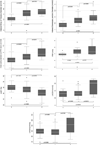Dilatation of the ascending aorta is associated with presence of aortic regurgitation in patients after repair of tetralogy of Fallot
- PMID: 27240599
- PMCID: PMC5127280
- DOI: 10.1007/s10554-016-0902-4
Dilatation of the ascending aorta is associated with presence of aortic regurgitation in patients after repair of tetralogy of Fallot
Abstract
To evaluate the association between aortic morphology and elasticity with aortic regurgitation in surgically corrected of tetralogy of Fallot (TOF) patients. We retrospectively identified 72 consecutive patients with surgically corrected TOF and 27 healthy controls who underwent cardiac MRI evaluation. Velocity-encoded cine MRI was used to quantify degree of aortic regurgitation (AR) in TOF patients. Ascending aorta diameters were measured at standard levels on MRA images. Aortic pulse-wave velocity (PWV) was quantified with MRI. Morphological and functional MRI variables were compared between groups of TOF patients with and without clinically relevant AR and controls. The association between aortic morphology and elasticity with the presence of AR was evaluated using univariate and multivariate logistic regression. The majority of TOF patients had only trace AR. Nine TOF patients (12 %) had an AR fraction higher than 15 %. Indexed aorta diameter at the sinotubular junction (p = 0.007), at the RPA level (p = 0.006), and low left ventricular ejection fraction (LVEF) (p = 0.015) showed the strongest associations with the presence of at least mild AR, which persisted after controlling for age and gender. Increased ascending aorta dimension is associated with AR in patients after repair of TOF. LVEF was also low in the group of patients with relevant AR compared to those without, suggesting even mild to moderate AR may contribute to LV dysfunction in these patients. Enlarged ascending aorta may be an indication for precise quantification of regurgitant fraction with MRI, since symptomatic patients may need aortic valve repair when moderate regurgitation is present.
Keywords: Aortic dilatation; Aortic insufficiency; MRI; Tetralogy of Fallot.
Conflict of interest statement
None of the authors have any conflict of interest to disclose.
Figures



References
-
- Murphy JG, Gersh BJ, Mair DD, et al. Long-term outcome in patients undergoing surgical repair of tetralogy of Fallot. N Engl J Med. 1993;329(9):593–599. - PubMed
-
- Nollert G, Fischlein T, Bouterwek S, Bohmer C, Klinner W, Reichart B. Long-term survival in patients with repair of tetralogy of Fallot: 36-year follow-up of 490 survivors of the first year after surgical repair. J Am Coll Cardiol. 1997;30(5):1374–1383. - PubMed
-
- Deanfield JE, Ho SY, Anderson RH, McKenna WJ, Allwork SP, Hallidie-Smith KA. Late sudden death after repair of tetralogy of Fallot: a clinicopathologic study. Circulation. 1983;67(3):626–631. - PubMed
-
- Niwa K. Aortic root dilatation in tetralogy of Fallot long-term after repair—histology of the aorta in tetralogy of Fallot: evidence of intrinsic aortopathy. Int J Cardiol. 2005;103(2):117–119. - PubMed
-
- Niwa K, Perloff JK, Bhuta SM, et al. Structural abnormalities of great arterial walls in congenital heart disease: light and electron microscopic analyses. Circulation. 2001;103(3):393–400. - PubMed
Publication types
MeSH terms
Grants and funding
LinkOut - more resources
Full Text Sources
Other Literature Sources
Medical
Research Materials

